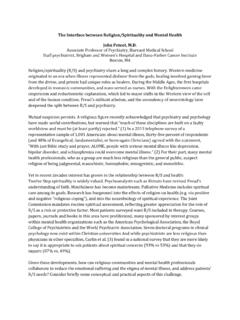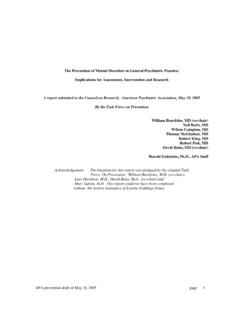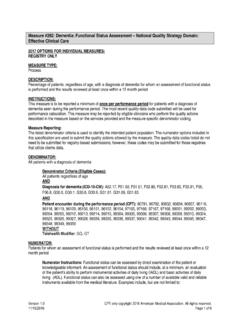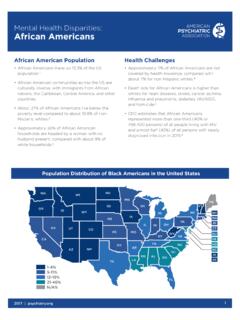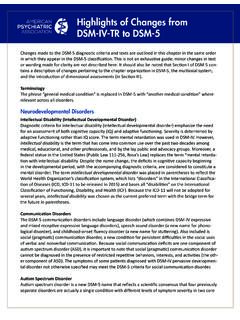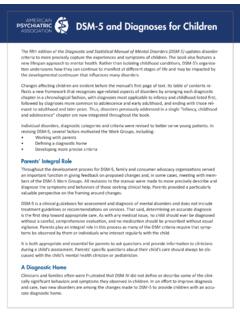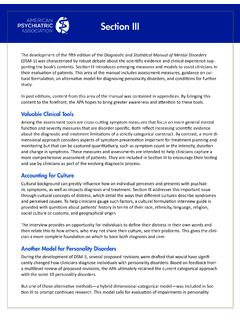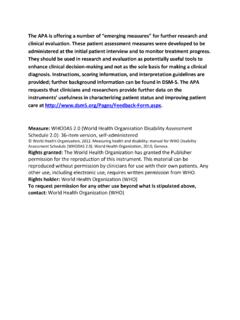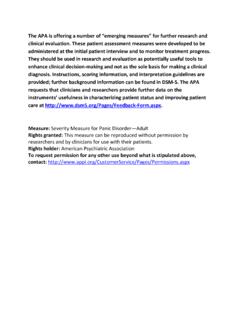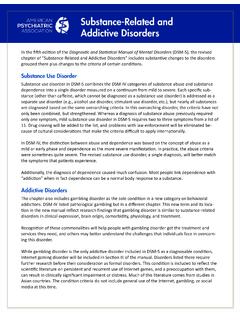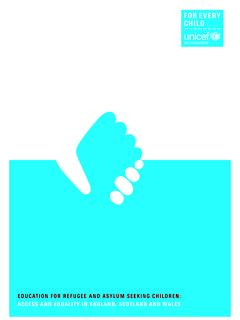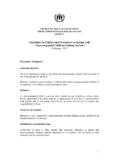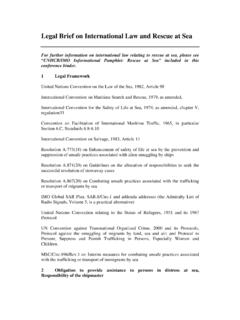Transcription of Mental Health Facts on Refugees, Asylum-seekers ...
1 1 Scope of the problemThe number of people displaced from their home countries due to war, armed conflict, political violence, and related threats are growing. If current trends continue, one in 100 persons will be a refugee in the near Unfortunately, most refugees, asylum seekers, unaccompanied minors, and other survivors of forced displacement will not receive needed Mental Health care due to scarcity of services and stigma against Mental Health care. Worldwide, over 65 million persons are currently displaced by war, armed conflict, or persecution, the majority of whom are located in low- and lower-middle income countries.
2 Globally, half of the refugees live in unstable and insecure situations. There are million asylum seekers and more than 25 million refugees, half of whom are under 18 years old. As of early Mental Health Facts on Refugees, Asylum-seekers , & Survivors of Forced Displacement2018, almost 31 million children worldwide have been displaced by violence and Refugees are defined as someone who owing to a well-founded fear of being persecuted for reasons of race, religion, nationality, membership of a particular social group, or political opinion, is outside the country of his nationality, and is unable to or, owing to such fear, is unwilling to avail himself of the protection of that country3.
3 An asylum seeker has also experienced persecution but has crossed borders to seek sanctuary. Refugees and asylum seekers differ only in where they are located when they make a request for experience of forcibly displaced youth is varied some have endured chronic pervasive exposure to interpersonal and community violence, the uncertainty of the future, personal MILLION forcibly millioninternally millionAsylum-seekers57% of UNHCR refugees came from 3 millionSouth millionSyriaREFUGEES, Asylum-seekers , & SURVIVORS OF FORCED DISPLACEMENT 2or family persecution, violent loss of loved ones, and an insecure environment5.
4 Others have experienced a shorter exposure to high violence such as active war. Some youth come from areas of armed conflict and war with their conscription into the armed forces as child soldiers , some arrive without parents or caretakers as unaccompanied and separated minors, and other youths flee with intact families. The migration experience for youth forcibly displaced from their homes to the is also varied. Refugee and asylum - seeking youth may travel by plane or train without exposure to violence or danger if they have resources. Others have long migration journeys across multiple countries, exposure to physical and sexual assault, hiding, and lack of basic needs such as food, clean water, and the ability to maintain personal hygiene6.
5 Oftentimes, forcibly displaced youth must abruptly leave all belongings except only the most necessary and quickly say goodbye to loved ones who may be unable to join. They do not necessarily want to leave the home environment and culture that raised them. Therefore, these youth lose not only material resources like housing, education, access to food and water, and security, but also social relationships and cultural supports. Refugees do not choose which country they would like to live in. The United Nations High Commissioner for Refugees makes recommendations to select countries. There are eight federal agencies, six security database biometric security checks, three in-person interviews with the Department of Homeland Security, and medical checks that are involved in the thorough screening of refugees which can take between 1-2 years7.
6 Historically, the resettlement program was one of the largest in the world since the 1970s, offering resettlement to the most vulnerable: at-risk women and children, female-headed households, elderly, and survivors of violence and torture, and those with acute medical needs. In the past decade, there were an average 75,000 refugees admitted into the , but that number has gone down significantly recently. Only 22,491 refugees were admitted in the fiscal year 2018- the lowest in more than 40 to a family separation policy, formally enacted in April 2018 that called for every illegal entry case across the border to be prosecuted, children (who could not be prosecuted) were separated from their parents.
7 Between October 2017 and April 2018, an estimated 700 families were separated. In June 2018, an executive order was signed to end family separations at the 1: Data from the Refugee Processing Center Health of survivors of forced displacement resettled in high-income countriesAbout one out of three asylum seekers and refugees experience high rates of depression, anxiety, and post-traumatic stress disorders (PTSD) , systematic reviews show that prevalence estimates of Mental Health disorders 3for this population vary widely from 20% to 80%10,11 specifically. 4 to 40% for anxiety, 5 to 44% for depression 9 to 36%12,13,14,15 in PTSD While most refugees and asylum seekers with PTSD and depression show a reduction over time, particularly if there are low resettlement stressors16,17 others may experience years of PTSD18, Mental Health care should, therefore be a priority for resettled youth20, as post-migration stressors such as prolonged detention, insecure immigration status, and limitations on work and education, can worsen Mental health21.
8 When individuals and families seek safety by leaving their homes, cultures, and communities due to the threats of violence and persecution, emotional distress can be heightened22. Once forcibly displaced persons reach the , they often face multiple postmigration stressors of poverty, insecure housing, unemployment, multiple moves with changes in neighborhoods, isolation, stressful legal issues, poor access to services, and general disadvantage in the host country, which can all adversely impact Mental health23,24,25; Systems of care for the Mental Health of refugees and asylum seekersProviding Mental Health care for refugees and asylum seekers should be done in partnership with the other social, cultural, and family supports around the individual.
9 Such an approach highlights the influence of environment on Mental well-being. Clinicians can serve as advocates by linking refugees with psychosocial support to assist with housing, legal aid, access to Health care, education, and and asylum seekers may be resistant to seeking Mental Health care due to beliefs that diagnosis will interfere with jobs and housing, that there is no treatment26, cultural values surrounding silence/disclosure27, differing beliefs surrounding etiology/manifestation of emotional Health , and lack of incorporation of these beliefs into care9. Figure 2: ORR Refugee Health Newsletter, 2013 Common structural barriers to care are lack of education about the Mental Health system and resources, Health insurance issues, transportation, language proficiency, or provider refusal to see refugees28.
10 Refugees may have barriers to seeking care, but Health systems may also have barriers to referring people for services, as only about 3% of refugees are referred to Mental Health services following screening29. Strengths and protective factors common to refugees and asylum -seekersDespite the high rate of exposure to traumatic events among the refugee population, many do not have chronic psychiatric impairment30,31. Clinicians should, therefore, make the distinction between normal responses to the abnormal situations of war, protracted violence, and other traumatic experiences that many conflict-affected persons face, and the more severe and less common psychiatric response.
